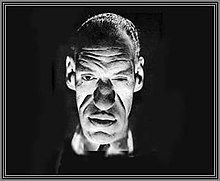Rondo Hatton
| Rondo Hatton | |
|---|---|

Hatton's acromegalic features made him a Hollywood horror film icon.
|
|
| Born |
April 22, 1894 Hagerstown, Maryland, U.S. |
| Died | February 2, 1946 (aged 51) Beverly Hills, California, U.S. |
| Occupation | Actor |
| Years active | 1930–1946 |
| Spouse(s) | Elizabeth Immell James (1926–1930; divorced) Mabel Housh (1934–1946; his death) |
Rondo Hatton (April 22, 1894 – February 2, 1946) was an American soldier, journalist and occasional actor with a minor career playing thuggish bit and extra parts in Hollywood B-movies, culminating in his elevation to horror movie star-status with Universal Studios in the last two years of his life, and posthumously as a movie cult icon. He was known for his unique facial features which were the result of acromegaly, a syndrome caused by a disorder of the pituitary gland. He was born in Hagerstown, Maryland to Missouri-born teachers.
Hatton was born in Hagerstown, Maryland. The family moved several times during Rondo's youth, to Hickory, North Carolina, and to Charles Town, West Virginia, and, finally, to Tampa, Florida, where family members owned a business. (E.J. Fleming's book, Hollywood Death and Scandal Sites: Seventeen Driving Tours with Directions and the Full Story, 2d ed., says that Hatton "moved around the country with his family before settling in Hillsborough, Florida.") He starred in track and football in high school and was designated Handsomest Boy in his class his senior year.
In Tampa, Hatton worked as a sportswriter for The Tampa Tribune. He continued working as a journalist until after World War I, when the symptoms of acromegaly developed.
Acromegaly distorted the shape of Hatton's head, face, and extremities in a gradual but consistent process. He eventually became severely disfigured by the disease. Because the symptoms developed in adulthood (as is common with the disorder), the disfigurement was incorrectly attributed later by film studio publicity departments to his exposure to a German mustard gas attack during service in World War I. Hatton served in combat and served on the Pancho Villa Expedition along the Mexican border and in France during World War I with the United States Army, from which he was discharged due to his illness.
...
Wikipedia
